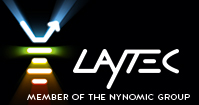Combined power of spectral sensing and industry proven EpiTT and EpiCurve® performance
 VCSELs grown on GaAs are currently emerging as a leading technology in rapidly expanding markets like Gesture Recognition, 3D imaging, datacomm and others. Utilizing the modular concept of our new Gen3 in-situ platform, LayTec has customized and expanded the related in-situ metrology performance for VCSEL epitaxy. Our new family of in-situ tools for VCSEL applications combines spectral reflectance measurements with the robust and industry proven EpiTT and EpiCurve® TT performance.
VCSELs grown on GaAs are currently emerging as a leading technology in rapidly expanding markets like Gesture Recognition, 3D imaging, datacomm and others. Utilizing the modular concept of our new Gen3 in-situ platform, LayTec has customized and expanded the related in-situ metrology performance for VCSEL epitaxy. Our new family of in-situ tools for VCSEL applications combines spectral reflectance measurements with the robust and industry proven EpiTT and EpiCurve® TT performance.
An upgrade from standard EpiTT to EpiTT VCSEL is simple and straight-forward, because the additional spectral sensing module (R-VCSEL) shares the optical head and the two optical fibers with EpiTT. Therefore, a single viewport at the MOCVD reactor is sufficient for EpiTT VCSEL or EpiCurve® TT VCSEL. The EpiCurve® TT VCSEL is a comprehensive 4-in-1 in-situ metrology tool measuring all 4 key epi parameters on all wafers in the reactor: wafer temperature, growth rates, wafer bow and the VCSEL’s spectral reflectance. Fig. 1 shows this 4-in-1 metrology tool mounted on an Aixtron G3 Planetary reactor top. This combination allows integrating the full EpiCurve® TT performance with the spectral monitoring of DBR (distributed Bragg reflector) stop-bands and cavity dip position.
High performance of EpiTT in industrial VCSEL applications
 For industrial VCSEL processes, EpiTT has a Return-on-Investment (RoI) of only a few months. The standard EpiTT offers all features necessary for GaAs/InP based epitaxy:
For industrial VCSEL processes, EpiTT has a Return-on-Investment (RoI) of only a few months. The standard EpiTT offers all features necessary for GaAs/InP based epitaxy:
- Wafer temperature with ±1K accuracy
- High accuracy in-situ growth rate (film thickness) measurement with XRD accuracy by 405/633/950 nm low-noise 3-wavelength reflectance
- 24/7 performance with automated data analysis and integrated interfaces to the MES/SPC systems of our customers
- Modular integration into EpiCurve®TT metrology for keeping lattice match of ternary and quaternary layers within narrow specification limits
The concept of additional spectral sensing
The additional spectral reflectance module delivers real-time information about the evolving DBR (distributed Bragg reflector) and cavity structures already during epitaxy in a customer chosen spectral range. Fig. 2 shows that the spectral reflectance during the growth of a VCSEL is shifted at growth temperature (Tg=650°C) to a longer wavelength as compared to the room temperature signatures.
 Fig. 2: Simulated in-situ data of 980 nm InGaAs/GaAs VCSEL growth (x=12%/90%DBRs) based on A.Mutig, PhD thesis (Technical University of Berlin).
Fig. 2: Simulated in-situ data of 980 nm InGaAs/GaAs VCSEL growth (x=12%/90%DBRs) based on A.Mutig, PhD thesis (Technical University of Berlin).
For seamless integration of spectral sensing into EpiTT, it is of importance to adjust the wafer temperature measurement appropriately. The high reflectance of the growing VCSEL structure in the near infra-red range reduces the emissivity of the wafer. Hence, based on the specific requirements of our VCSEL customers, the EpiTT VCSEL optical set-up can be customized for minimizing trade-offs between wafer temperature measurement and spectral sensing.
LayTec’s EpiNet software performance for EpiTT VCSEL
EpiNet is LayTec’s control and analysis software for EpiTT, EpiCurve® TT and Pyro 400 products. EpiNet converts in-situ data into profitable information. For VCSEL applications, EpiNet offers:
- Automated spectral analysis regarding DBR (distributed Bragg reflector) signatures position, DBR shape and amplitude as well of VCSEL cavity resonance position
- Transfer of selected multi-waveleght reflectance transients to EpiNet
- Automated feed-forward of these additional data lines to the customer's MES/SPC systems
For further information please contact info@laytec.de or call +49-30-89 00 55-0.
In-situ news
- Characterization of 2D materials growth 2022
- Best practices from the field: How to enhance epitaxy process performance by in-situ data
- EpiCurve® TT: AlInN composition control for III-Nitride VCSELs
- Major laser supplier chooses EpiTT FaceT for yield improvement
- EpiTT: optimizing MBE growth of InP-based quantum cascade lasers
- Plenary Talk at EWMOVPE 2019: Metrology for UV-LEDs, VCSEL and Power electronics
- EWMOVPE 2019: In-situ metrology enabling MOCVD on InP based materials on III-V on Si/SiO2 substrates for silicon photonics
- EpiX – a modular wafer mapping station for compound semiconductor research
- EpiTT Band Edge – for MBE of InP based VCSEL devices
- GaAs based edge-emitting high-power IR lasers – yield ramp-up by EpiTT FaceT
- EpiTT VCSEL – shipments to leading VCSEL manufacturer
- In-situ metrology system shipped to GaN-on-SiC customer
- Optimizing quantum cascade laser (QCL) epitaxy with EpiCurve® TTpocket satellite configuration
- In-situ metrology for VCSEL epitaxy with additional spectral reflectance sensing
- UV-C LEDs: AlGaN surface morphology monitored by 280 nm reflectance
- AIXTRON qualifies LayTec EpiNet 2016 software
- IQE equips complete fab with LayTec tools for MOCVD process monitoring
- AbsoluT 400 for temperature calibration of Pyro 400 is on the market!
- In-situ power for RF and power electronics
- Advanced in-situ analysis for UV LEDs

